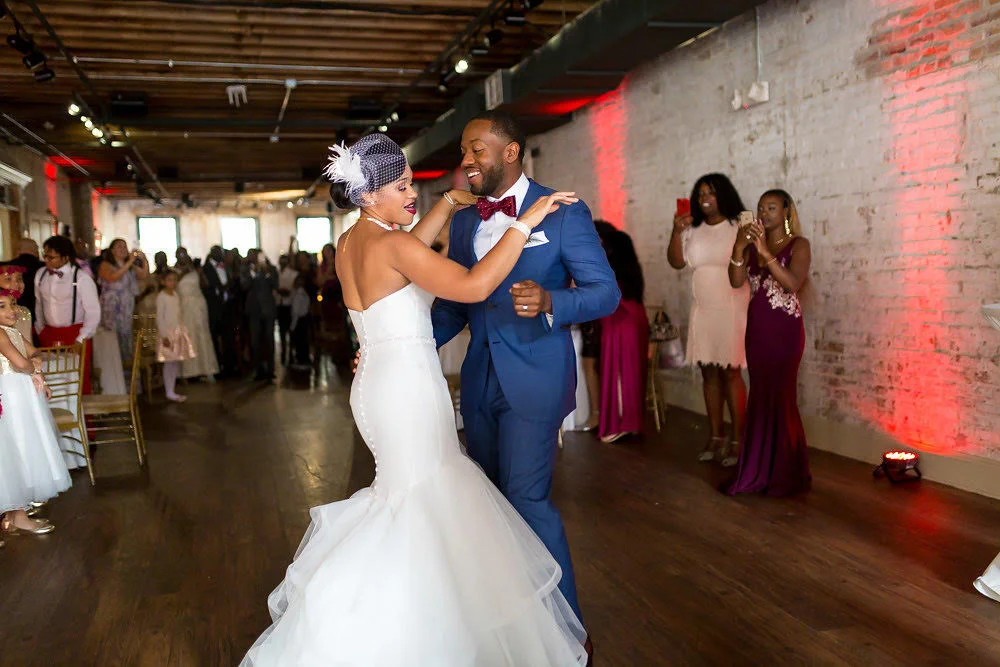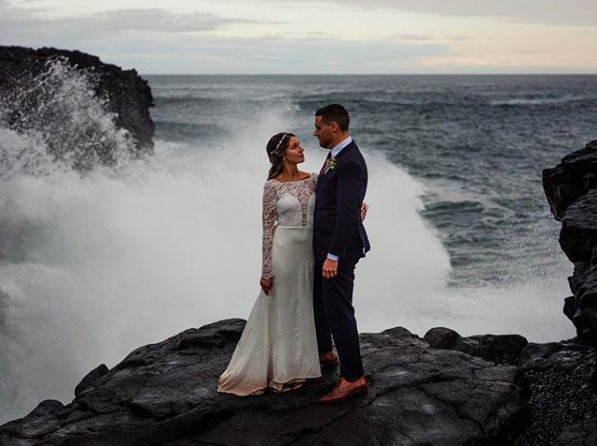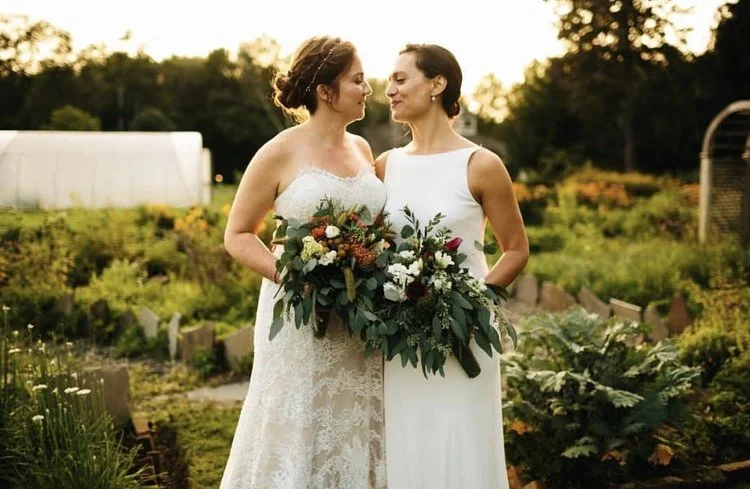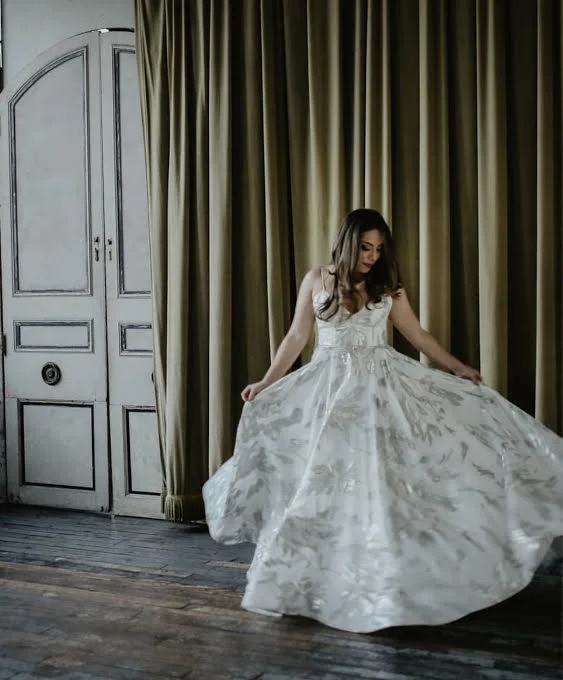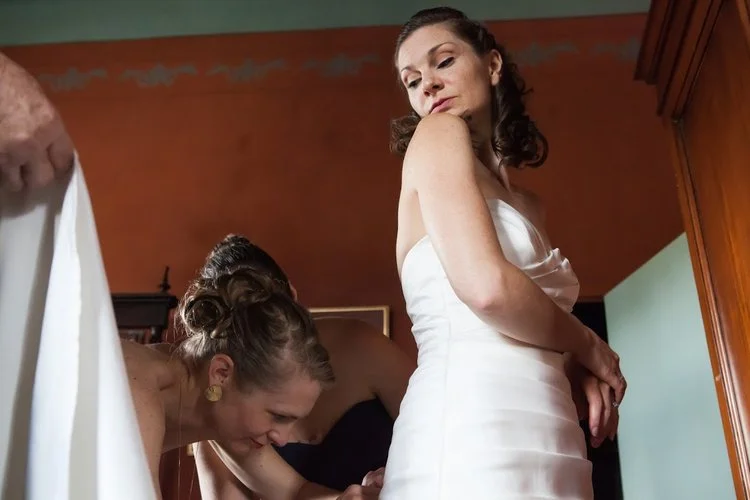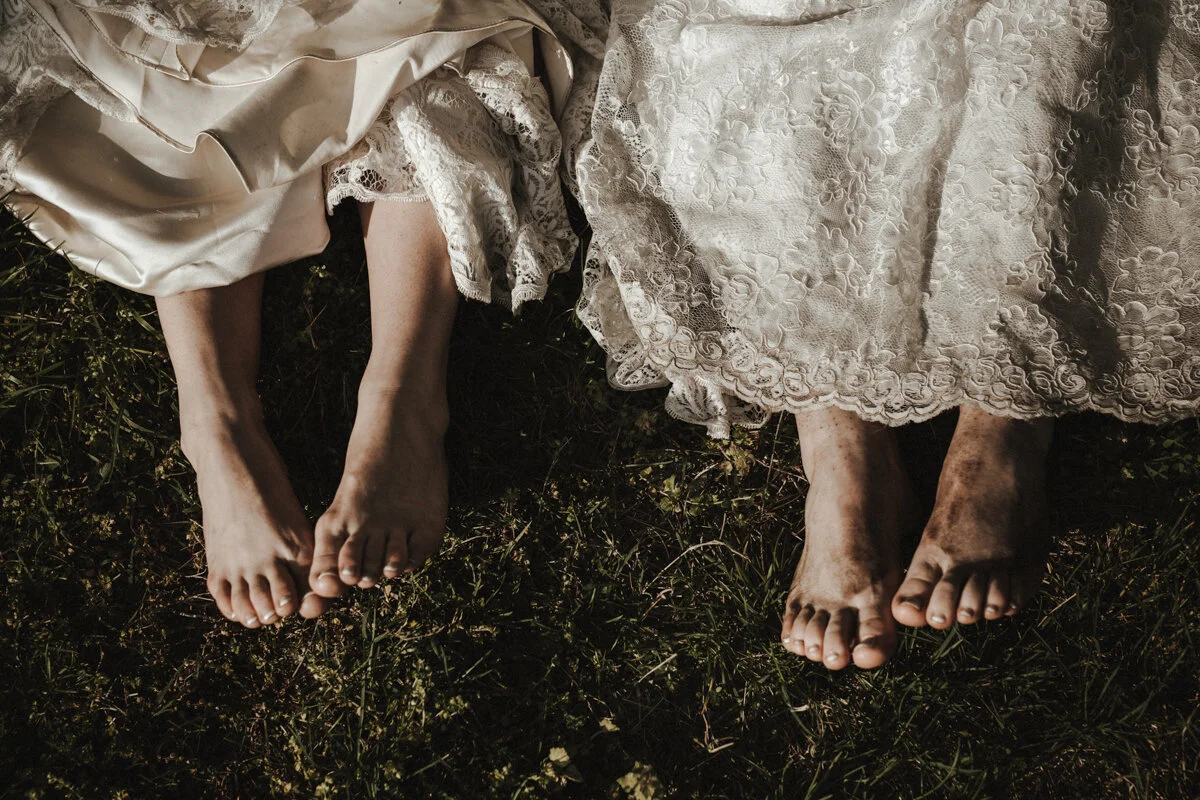Everything You Ever Wanted To Know About Altering or Customizing A Wedding Dress // AMadden Tailoring
/Catalyst Wedding Co. may receive compensation or products from companies mentioned in this article. This helps support our site.
For us lay-people, the mysteries of bridal gown tailoring can seem like pure magic. We sat down with the expert, Amanda Madden of AMadden Tailoring, and we asked her everything we have ever wanted to know about altering, customizing, and creating wedding dresses!
1. What is a bustle? Are there different styles of bustles? What are the effects of the different bustle styles?
A bustle is a way of pulling up the train of the dress so that you can dance and move with ease once the ceremony is over. There are many ways to bustle a gown and the “best” way is different for every gown. At my shop, I try to work with both the dress and the bride to find the one that looks and functions the best. Even if you aren’t sure you are going to use it, I recommend having one put in. It will make all the difference when it’s time to hit the dance floor!
2. Can the shape of a dress be significantly changed?
Every dress has its limitations, but every dress also has a lot of possibilities. I wish I could be more specific, but it is usually on a case-by-case basis that depends on the dress you have and the changes you want to make. I have had people come to me who thought that what they wanted was impossible, and it was very doable. I have also had cases where someone came to me with what they thought would be a simple change, but wasn’t actually feasible for their dress. Before counting on making those changes, I recommend that you consult with a qualified bridal tailor. Often the salespeople at the bridal shop will assure brides that anything is possible with the gown. Unfortunately, that isn’t always the case, but sometimes you would be amazed at what can be done!
3. Is it possible to make a dress bigger?
Yes! Again, every dress is different, but many dresses have enough seam allowance to let the gown out between 1”-3”. A talented bridal tailor can also add fabric, lace, or beadwork to extend the dress further. A dress that is lacy is easier to extend invisibly, provided that you have extra lace from the dress or a similar enough lace to blend in. You want to get as close a fit as you can, but if you have gained a few pounds since ordering, or if you just love that one dress and there is only a size too small, don’t panic!
Photo by Nordica Photography
4. I was told I could buy a dress much bigger than my size. How big is too big?
As always, it depends on the dress. Strapless dresses or dresses with shoulder straps can usually be taken in more easily than ones with sleeves. I have taken in a dress from a size 14 to a size 2 before, but it is daunting, and there are some stylistic changes that are involved. A substantially larger dress than your size will require a great deal of work to get a good fit, so you can expect to pay more for alterations, but often it can be done.
5. What is your opinion on adding or removing straps?
Adding straps is usually not a problem as long as there is fabric available from the dressmaker, or the dress can be easily matched. It often gives a little needed support for larger busts, especially if you go with a ½” strap as opposed to a spaghetti strap. Removing straps is a little dicier, as it depends on the structure of the gown. If the gown is not backless and has enough structure to stay up without them, it shouldn’t be a problem. I have had brides come in who have had the straps removed at the gown shop and the dress won’t stay up because is has no back. In those cases, the straps will have to be replaced to keep the dress up.
6. Can my mom's wedding dress be refitted so that it can also be my wedding dress?
It is one of my favorite things to do! Often the vintage styles, especially before the 1980s, are extremely small. If a dress can’t be sized up or let out, we have taken parts from the gown and incorporated them into a different gown or made a custom gown using elements from the original. I once had a bride bring me her mother’s dress from the 80s, which she didn’t love stylistically and a picture of her grandmother’s dress from the 50s that she loved. The 80s dress had tons of lace and fabric but was also too small for the bride. In the end I made a dress using the lace and fabric from the 80s dress that mimicked the 50s dress, which was cocktail length. It was gorgeous, and the bride and her family loved it. Vintage gowns are my first love, so I really enjoy finding creative ways to help the bride update her vintage gown.
Photo by Chaz Cruz
7. Can beading be removed or added?
Yes to both, although when adding beading to a gown, it should be noted that it is done by hand, is extremely time consuming, and requires specialized skills, so you should expect to pay for it accordingly.
8. What is boning?
Boning is a series of plastic strips that are sewn into the seams of many gowns. It provides structure, especially in a strapless gown, so that the dress will stand up in the right places, rather than droop and pucker. With properly installed boning, most dresses will not require you to wear a bra and will do all the support work needed. Boning can be altered, added, or removed to make the dress more comfortable or to give more support.
9. Can the color of a dress be changed?
I don’t work with dyes, but sometimes I have changed the lining of the dress or added colored lace to give a different effect. If the dress is ivory chiffon or tulle over ivory lining, changing the lining to blush or blue or any color will ultimately change the dress color overall. Multi-colored 3D lace is trending right now, and I have added bursts of color using that in a few dresses recently.
If you are planning to try to have a dress dyed, I strongly recommend using a qualified professional and getting a dye sample made from all of the fabrics used in the dress first. I have seen some dyeing disasters!
Photo by Enamor Film
10. The dress is too much; can I remove the train?
Absolutely. The dress can be made the same length all around in most cases, sometime very easily and sometimes with a lot more work. Sometimes just taking out the extra layers of crinoline can help get the desired fullness. Often when a bride tries on her actual gown (not the sample) for the first time, it is overwhelming. Extra length on the bottom of the dress always gives the illusion of the dress being significantly bigger all around. Many, many times, once we got to the point where the bride could see the dress fitted to the correct length, she changed her mind about removing the train or the crinoline.
11. Are some materials easier for alterationists to work with than others?
Finer silks such as charmeuse are always a little trickier, but a qualified bridal tailor has seen it all and should be able to handle whatever you bring her! When it comes to dresses made from delicate fabrics where every detail will show, such as a plain silk dress, you want to handle the dress as little as possible, so do your best to get the best fit possible when ordering!
12. My breasts don't fit in the dress. What are my options?
Breasts seem to always be the issue when it comes to dress fitting! Every dress and every body is different, but there are many options to give a dress more coverage. Most options involve adding fabric, whether it be matching lace or a contrasting detail fabric, we have had success adding coverage to brides that were open to few changes. We try to get creative to work with the individual style of each bride.
Photo by Wilde Scout
13. I'm really short and nothing fits my torso. What changes can be made?
Very often, if the dress has a waistline seam, the dress bodice can be cut down to fit. If you have a short torso, I recommend buying a dress that has a defined waistline with a seam that can be moved up to shorten the bodice. We do it with wedding dresses and other formal gowns all the time!
14. Do you recommend buying a sample gown or secondhand gown? What do I need to know before buying?
Yes! I absolutely do. However, keep in mind that paying less for the dress doesn’t necessarily mean that alterations will be cheaper, too. If the dress is significantly bigger or smaller than you need, alterations can be pricey. Also, if there is damage that will need to be repaired or covered up, it can affect the price. Having said that, a sample gown can open you up to some great possibilities! One bride brought me a dress that she bought for $200. It was pretty worn and had a lot of damage. We used it as the skeleton for her dream dress by adding lace and making something new from something old. Later, she came back for her family ceremony, and we added more lace to take it from strapless dress to a gown with a full back and sleeves to cover her tattoos. A current bride brought me a sample gown five sizes too big. We are making a whole new gown from it, so keep an eye out for our before and after pics!
**When buying a sample gown, be sure to have it cleaned BEFORE you have it altered! Any changes (shrinkage, damage, remaining stains) can be addressed in alterations, but if the dress is already altered and problems occur in cleaning, you may be in trouble!
15. How early should I start thinking about alterations? How much should I budget?
Every tailor has a different policy, so if you have a preferred tailor you will want to check with them as soon as you start planning your dress. Here we generally start alterations 6-8 weeks before the wedding — earlier if there is a lot of work to be done and later if there is very little. For a custom gown, we like to begin the process 10-12 months before the wedding, but sometimes will go as little as six months. We encourage brides to book a consultation as soon as they have the dress if they are thinking of having a custom gown made. That way they can find out what work needs to be done, how much they should expect to pay, and can make sure the tailor is the right fit for them.
Many tailors book up during the busy season, so if you know who you want to work with, you will want to get on their calendar as early as possible. Right now I already have brides booked for 2019.
As far as cost, it varies based on where you are and the the experience level of the tailor. In my area (Brooklyn, New York), bridal alterations average around $600. Someone less experienced or with lower overhead may charge less, just as someone more experienced in a fancier space may charge significantly more. Most tailors will be more than happy to give you a price range for working with them before you get started, but they generally cannot give you a price or estimate for your gown without seeing it in person. We offer a consultation for a small fee where we can meet with you, see the dress, assess the fit, and give you a no-obligation estimate. If you do choose to do alterations with us, the fee comes off the final balance. Many tailors offer a variation of the same deal. I definitely recommend a consultation when you can get one!
Photo by Melinda Borbely
16. What about having a gown or outfit custom-made for my wedding?
I love designing a custom piece with a client! It is a great opportunity to express individuality on your big day. Keep in mind that a well-made custom piece will not be cheaper than a store-bought one. Custom gowns and suits can range from $2000+ to tens of thousands of dollars depending on what you want. It should be a process of creation between you and your designer. Make sure you feel very comfortable with the tailor and that you are on the same page. You want to find someone that you are comfortable being honest with if the design isn’t going the way you want. Communication from the start is key when working with your tailor on a custom piece, as well as alterations! Custom design is a great way to achieve a one-of-a-kind piece that expresses who you are, but if it’s not done well with ample planning and communication, it can be a nightmare for both the client and the tailor.
17. What kind of bra or undergarments should I get to wear with my gown?
Personally, I recommend meeting with your tailor before getting any undergarments. Many times people have come with pricey specialty undergarments only to find that we can easily give them the structure or support they need from the dress through the fitting process. Some brides/gowns will need a bra to get the desired look, but that should be assessed with your tailor in either your consultation or alterations appointments.
When it comes to Spanx or shapewear, it’s a personal choice, but for me the answer is always “no.” Be free! Be comfortable! Be your beautiful self! I’ve never liked the “beauty is pain” idea, and your wedding day is a day for you to shine, not suffer!
18. I found a dress I love, but I need more coverage for religious requirements, tattoo coverage, etc. What are my options?
Many times for religious ceremonies that require more coverage, we have started with a strapless dress and added anything from small cap sleeves all the way to full opaque coverage of arms, neck, and back. This is done most easily with lace gowns or gowns that feature lace.
Another option, if you want removable coverage, is wearing a topper. It is a like a little shirt or jacket made of lace or chiffon that can be worn with your gown. They have become very popular and can easily be found in most bridal shops that sell separates or custom made to match your gown.
Have more questions about altering or customizing your wedding dress?
Contact AMadden Tailoring to schedule a consultation.
AMadden Tailoring is a full-service tailoring boutique located in the heart of Brooklyn's Gowanus neighborhood on Third Avenue between 11th and 12th Streets. We run an atelier-style shop with an expertise in couture bridal alterations and fitting, but we bring this same couture sensibility to any alterations, from shortening jacket sleeves to hemming ball gowns. Whether you are looking to improve the fit of ready-to-wear clothing or searching for someone you can trust to alter your favorite designer outfit, we can assure you that we bring only the highest standards of hand- and machine-sewing to your garments.
What to Read Next:
- 22 Designer Plus-Size Wedding Dresses That Prove Your Body is Perfect As-Is
- 8 Picks for Wedding Attire That Breaks Down All the Gender Norms
- Anne Barge Offers Plus Size Designer Wedding Gowns with Curve Couture
- How to Ditch the White Wedding Dress & Just Be You!
- 10 Tips for Stress-Free Wedding Dress Shopping
- 7 Tips for Wedding Dress Shopping in a Wheelchair
- 10 Outfits That Prove Western Brides Don't Need White Wedding Dresses

